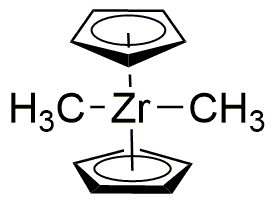Bis(cyclopentadienyl)dimethylzirconium(IV) is widely utilized in research focused on
- Catalysis: This compound serves as a catalyst in various polymerization reactions, particularly in the production of high-performance polymers. Its unique structure allows for efficient activation of monomers, leading to better control over polymer properties.
- Material Science: It is used in the synthesis of advanced materials, including nanocomposites and thin films. Researchers appreciate its ability to enhance the mechanical and thermal properties of materials, making them suitable for demanding applications.
- Organic Synthesis: The compound plays a crucial role in organic synthesis as a reagent for the formation of carbon-carbon bonds. This application is particularly valuable in the pharmaceutical industry for developing complex drug molecules.
- Surface Modification: It is employed in surface science to modify the properties of various substrates. This application is essential in electronics and optics, where tailored surface characteristics can lead to improved device performance.
- Research and Development: The compound is a valuable tool in academic and industrial research settings, facilitating the exploration of new chemical pathways and the development of innovative technologies.
General Information
Properties
Safety and Regulations
Applications
Bis(cyclopentadienyl)dimethylzirconium(IV) is widely utilized in research focused on
- Catalysis: This compound serves as a catalyst in various polymerization reactions, particularly in the production of high-performance polymers. Its unique structure allows for efficient activation of monomers, leading to better control over polymer properties.
- Material Science: It is used in the synthesis of advanced materials, including nanocomposites and thin films. Researchers appreciate its ability to enhance the mechanical and thermal properties of materials, making them suitable for demanding applications.
- Organic Synthesis: The compound plays a crucial role in organic synthesis as a reagent for the formation of carbon-carbon bonds. This application is particularly valuable in the pharmaceutical industry for developing complex drug molecules.
- Surface Modification: It is employed in surface science to modify the properties of various substrates. This application is essential in electronics and optics, where tailored surface characteristics can lead to improved device performance.
- Research and Development: The compound is a valuable tool in academic and industrial research settings, facilitating the exploration of new chemical pathways and the development of innovative technologies.
Documents
Safety Data Sheets (SDS)
The SDS provides comprehensive safety information on handling, storage, and disposal of the product.
Product Specification (PS)
The PS provides a comprehensive breakdown of the product’s properties, including chemical composition, physical state, purity, and storage requirements. It also details acceptable quality ranges and the product's intended applications.
Certificates of Analysis (COA)
Search for Certificates of Analysis (COA) by entering the products Lot Number. Lot and Batch Numbers can be found on a product’s label following the words ‘Lot’ or ‘Batch’.
*Catalog Number
*Lot Number
Certificates Of Origin (COO)
This COO confirms the country where the product was manufactured, and also details the materials and components used in it and whether it is derived from natural, synthetic, or other specific sources. This certificate may be required for customs, trade, and regulatory compliance.
*Catalog Number
*Lot Number
Safety Data Sheets (SDS)
The SDS provides comprehensive safety information on handling, storage, and disposal of the product.
DownloadProduct Specification (PS)
The PS provides a comprehensive breakdown of the product’s properties, including chemical composition, physical state, purity, and storage requirements. It also details acceptable quality ranges and the product's intended applications.
DownloadCertificates of Analysis (COA)
Search for Certificates of Analysis (COA) by entering the products Lot Number. Lot and Batch Numbers can be found on a product’s label following the words ‘Lot’ or ‘Batch’.
*Catalog Number
*Lot Number
Certificates Of Origin (COO)
This COO confirms the country where the product was manufactured, and also details the materials and components used in it and whether it is derived from natural, synthetic, or other specific sources. This certificate may be required for customs, trade, and regulatory compliance.


